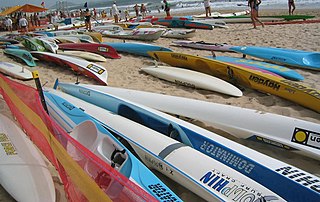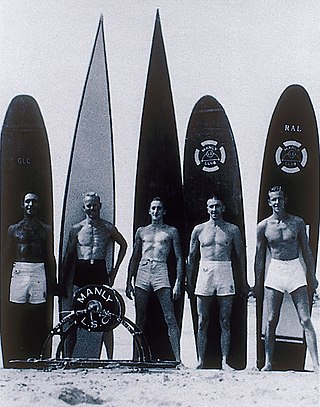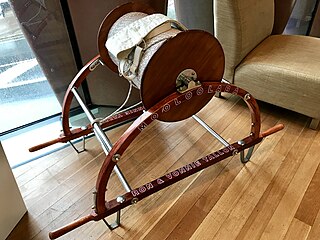
Surf lifesaving is a multifaceted social movement that comprises key aspects of voluntary lifeguard services and competitive surf sport. Originating in early 20th century Australia, the movement has expanded globally to other countries, including New Zealand, Ireland, South Africa, and the United Kingdom. Surf lifesavers in Australia are colloquially known as "Clubbies".

Tamarama is a beachside suburb, eastern suburb of Sydney, in the state of New South Wales, Australia. Tamarama is 6 kilometres east of the Sydney central business district, in the local government area of Waverley Council.

Clovelly is a small beach-side suburb in Sydney's Eastern Suburbs, in the state of New South Wales, Australia. Clovelly is located 8 kilometres south-east of the Sydney central business district, in the local government area of the City of Randwick, within the Federal Division of Wentworth.
Surf Life Saving Northern Region is the largest of four regions that make up Surf Life Saving New Zealand. As of the 2021/2022 season, it is made up of 18 clubs that look after 22 patrol locations from Ahipara to Raglan on the West Coast and from Whangārei Heads to Takapuna on the East Coast.

The Manly Life Saving Club is one of Australia's oldest Surf Life Saving Clubs, founded in 1911; located in the Sydney suburb of Manly, in the Northern Beaches Council in New South Wales.

Cronulla Beach, is a patrolled beach on Bate Bay in the Sydney suburb of Cronulla, New South Wales, Australia. The Cronulla Pavilion and the Cronulla Lifesaving Club are two prominent buildings located close to the sand. Cronulla Park sits behind the beach. The Cronulla Rock Pools are between Cronulla Beach and North Cronulla beach. The Alley is the local name given to the area between Cronulla Beach and North Cronulla Beach. Shark Island is a dangerous reef break, located off Cronulla Beach.

Bilinga is a southern coastal suburb in the City of Gold Coast, Queensland, Australia. It is on the border with New South Wales. In the 2021 census, Bilinga had a population of 1,883 people.

The Cronulla District LifeSaver Rescue Service works with the Water Police, NSW Police, NSW Maritime, Coast Guard, PolAir Helicopters, Westpac Life Saver Rescue Helicopters, Bate Bay Surf Life Saving Clubs as well as clubs in the Royal National Park, and CareFlight helicopters in providing rescue and emergency medical care to the people on Sydney's waterways.

The Coogee Surf Life Saving Club is a foundation member of the surf lifesaving movement in Australia. It was founded in 1907 by a group of concerned locals and has a proud history of no lives being lost whilst its members have patrolled. Coogee SLSC celebrated its 100-year anniversary in 2007, the Year of the Lifesaver.

Surf Life Saving Australia (SLSA) is an Australian not-for-profit community organisation that promotes water safety and provides surf rescue services.

The surf life saving reel was a beach life saving apparatus from Australia.
The South Port Surf Lifesaving Club was established in 1959 in the coastal Adelaide suburb of Port Noarlunga, South Australia, and it is currently situated in the sand dunes at the mouth of the Onkaparinga River Estuary. Due to its location at the mouth of a major South Australian river and its position in Gulf St Vincent, South Port is a renowned surfing beach for both board riders and body surfers.
The Bondi Surf Bathers' Life Saving Club is Australia's oldest Surf Life Saving Club, founded in 1907. The club was officially established on 21 February 1907 at the Royal Hotel in Bondi Beach, Sydney, New South Wales. The clubs aim is to ensure "No Lives Lost" at Bondi Beach and is a volunteer organisation that patrols Bondi Beach from October to April every year.
The Palm Beach Surf Life Saving Club is an Australian Surf Life Saving Club. The Club offers a range of activities and encourages members to continually develop and update their lifesaving skills. It is located at the southern end of Palm Beach, New South Wales, and members provide voluntary patrols on weekends and public holidays. Its members participate in internal and external competitions. Palm Beach Surf Life Saving Club is a voluntary, non-for-profit organisation. It is considered that "if you have on your resume that you're a member of Palm Beach Surf Club, you've really made Sydney's social set."

The Cronulla Surf Life Saving Club, was one of the first surf clubs established in Australia in 1907. The club is located in the southern Sydney suburb of Cronulla, which had very humble beginnings in a tram carriage and today the clubhouse is housed in a magnificent art deco building on the beachfront, that was built in 1940.
The North Bondi Surf Life Saving Club is a foundation member of the surf lifesaving movement in Australia. It was founded in 1907 by a group of concerned locals and has a proud history of no lives being lost whilst its members have patrolled.
The Wanda Surf Lifesaving Club was established in 1946 after World War II by a group of men who banded together, from the North Cronulla Surf Life Saving Club who were being asked to patrol this stretch of beach, being a considerable distance from the Cronulla area. The colours of Army red, Air Force blue, and Navy blue were adopted as the club colours. The club, located on Marine Esplanade, has grown in size to its current membership of over 900 male and female members, ranging in age from five-year-old Nippers to the original Founding Members.
The Freshwater Surf Life Saving Club, established in 1908, is located at Freshwater Beach in Australia. It has become a large volunteer organization with strong community bonds. The club was founded by a push from government to foster safer beach practices. It is a part of Surf Life Saving Australia, a not-for-profit organization committed to keeping the beach safe for patrons and providing beach rescue services. A visit to the club from United States' surfer, Duke Kahanamoku, in 1914 helped initiate the sport of surfing in Australia.












